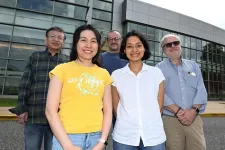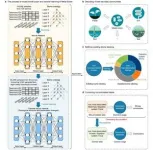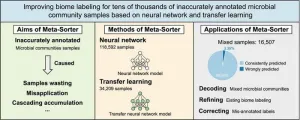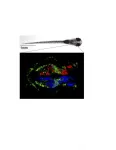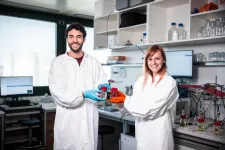(Press-News.org) UPTON, NY—Researchers at the Center for Functional Nanomaterials (CFN), a U.S. Department of Energy (DOE) Office of Science User Facility at DOE’s Brookhaven National Laboratory, and Northrop Grumman, a multinational aerospace and defense technology company, have found a way to maintain valley polarization at room temperature using novel materials and techniques. This discovery could lead to devices that store and process information in novel ways using this technology without the need to keep them at ultra-low temperatures. Their research was recently published in Nature Communications.
One of the paths being explored to achieve these devices is a relatively new field called “valleytronics”. A material’s electronic band structure—the range of energy levels in each atom’s electron configurations—can dip up or down. These peaks and troughs are known as “valleys.” Some materials have multiple valleys with the same energy. An electron in a system like this can occupy any one of these valleys, presenting a unique way to store and process information based on which valley the electron occupies. One challenge, however, has been the effort and expense of maintaining the low temperatures needed to keep valley polarization stable. Without this stability, devices would begin to lose information. In order to make a technology like this feasible for practical, affordable applications, experts would need to find a way to around this constraint.
Exploring 2D Landscapes for the Perfect Valleys
Transition metal dichalcogenides (TMDs) are interesting, layered materials that can be, at their thinnest, only few atoms thick. Each layer in the material consists of a two-dimensional (2D) sheet of transition metal atoms sandwiched between chalcogen atoms. While the metal and the chalcogen are strongly bound by covalent bonds in a layer, adjacent layers are only weakly bound by van der Waal’s interactions. The weak bonds that hold these layers together enable TMDs to be exfoliated down to a monolayer that’s only one “molecule” thick. These are often referred to as 2D materials.
The team at CFN synthesized single crystals of chiral lead halide perovskites (R/S-NEAPbI3). Chirality describes a set of objects, like molecules, that are a mirror image of each other but can’t be superimposed. It is derived from the Greek word for “hands,” a perfect example of chirality. The two shapes are identical, but if you put one hand on top of the other, they will not align. This asymmetry is important for controlling valley polarization.
Flakes of this material, roughly 500 nanometers thick or five-thousandths the thickness of a human hair, were layered onto a monolayer of molybdenum disulfide (MoS2) TMD to create what is known as a heterostructure. By combining different 2D materials with properties that affect the charge transfer at the interface between the two materials, these heterostructures open up a world of possibility.
After creating and characterizing this heterostructure, the team was eager to see how it behaved.
A Degree of Freedom
“TMDs have two valleys with the same energy,” explained Shreetu Shrestha, a postdoctoral research associate at CFN and the author of this paper. “An electron can be in one valley or the other, which gives it an additional degree of freedom. Information can then be stored based on which valley an electron occupies.”
To get a better picture of the material’s behavior, the team leveraged tools at CFN’s Advanced Optical Spectroscopy and Microscopy facility. Scientists used a linearly polarized laser to excite the heterostructure they fabricated and then measured the light that was emitted from the molybdenum disulfide TMD using a confocal microscope. They performed the same process with a TMD that didn’t have the chiral lead halide perovskite layer added.
During these advanced experiments, the researchers noticed something interesting about the way light was emitted. The heterostructure had a lower emission than the bare TMD. The researchers attributed this behavior to the charge transferred from the TMD to the perovskite in the heterostructure. Using ultrafast spectroscopy, the researchers found that the charge transfers very quickly—only a few trillionths of a second.
The team also found that the intensity of the left and right circularly polarized components of the light emitted depends on the handedness of the chiral perovskite used. The chiral nature of the perovskite acted like a filter for electrons with different spin. Depending on the handedness of the chiral perovskite, electrons that spin either up or down were preferentially transferred from one valley over electrons with the opposite spin in the other valley. This phenomenon would enable researchers to selectively populate valleys and use their occupation in the same way current transistors on computers store the 1s and 0s of binary bits.
“An important point to highlight in this experiment is that these results were realized at room temperature, which is where the whole field should move,” said Mircea Cotlet, a materials scientist at Brookhaven Lab and the principal investigator of the project. “Keeping hardware at the low temperatures that were being used is so much more complex and costly. It’s encouraging to see these kinds of material properties at room temperature.”
While valleytronics research is still at an early stage, researchers have already been thinking about possible applications. This technology could improve existing devices in surprising ways, expanding the capabilities of classical computers, but it could also be a component in the hardware of the future.
“This would help make classical computing more efficient,” said Shrestha, “but this technology could also be harnessed for quantum information science, which includes quantum computing, or even quantum sensing. These atomically thin materials have unique quantum properties, which we should be able to take advantage of.”
Fostering Collaboration and Innovation
CFN users and collaborators come from a wide range of fields in academia, research, and industry. This experiment involved contribution of a long-time collaborator from American global aerospace and defense technology company Northrop Grumman. In 2021, DOE’s Office of Energy Efficiency and Renewable Energy (EERE) awarded CFN with funding to collaborate with Northrop Grumman through the Technologist in Residence (TIR) program. The TIR program pairs senior technical staff from national labs and industry to conduct research and development. Programs like this strengthen national lab–industry relationships while advancing innovation in U.S. manufacturing and promoting economic growth and energy security.
“Our collaborations with Northrop Grumman and Don DiMarzio go back to 2015,” said Cotlet. “We have a mutual interest in 2D materials, particularly how they will help create the next generation of computers. It's encouraging to have the expertise of so many different people here under one roof. We are a user facility with access to a variety of high-end instruments and techniques which give us the ability to put all this information together.”
This work also allowed Shrestha and Cotlet to expand on the continued research that they have both been doing on TMDs and charge transfer.
“I had worked with perovskites during my PhD research and my first postdoctoral position,” said Shrestha, “so we were able to combine my expertise in that area with Mircea’s expertise in TMDs and the optical instruments we have in CFN’s Advanced Optical Spectroscopy and Microscopy facility to discover something promising. I was also excited to work with Suji Park and Xiao Tong of CFN and Mingxing Li, a scientist who was previously with CFN and is now at Innovare. This kind of understanding wouldn’t be possible without a collective effort and access to all of these high-end facilities under a single rooftop. I’m excited to see where this work leads and look forward to contributing more insight to CFN’s 2D materials program.”
Brookhaven National Laboratory is supported by the Office of Science of the U.S. Department of Energy. The Office of Science is the single largest supporter of basic research in the physical sciences in the United States and is working to address some of the most pressing challenges of our time. For more information, visit science.energy.gov.
Follow @BrookhavenLab on social media. Find us on Instagram, LinkedIn, Twitter, and Facebook.
Related Links
Brookhaven Lab and Northrop Grumman to Further Lab-Industry Collaborations
Q&A with CFN User Don DiMarzio
Interfacial Charge Transfer in Atomically Thin 2D Transition-Metal Dichalcogenide Heterostructures END
Valleytronics is warming up at Brookhaven Lab
CFN and Northrop Grumman researchers bring an innovative way to store and process information up to room temperature
2023-09-08
ELSE PRESS RELEASES FROM THIS DATE:
Refining biome labeling for microbial community samples: AI approach unravels hidden
2023-09-08
In a groundbreaking study published on July 26, 2023, in the journal Environmental Science and Ecotechnology, researchers from Huazhong University of Science and Technology have introduced "Meta-Sorter," an AI-based method that leverages neural networks and transfer learning to significantly improve biome labeling for thousands of microbiome samples in the MGnify database, especially those with incomplete information. The Meta-Sorter approach comprises two crucial steps. Firstly, a neural network model is meticulously constructed using 118,592 microbial samples from 134 biomes and their respective biome ontology, boasting an impressive average ...
Exercise-induced hormone irisin may reduce Alzheimer’s disease plaque and tangle pathology in the brain
2023-09-08
BOSTON – Researchers who previously developed the first 3D human cell culture models of Alzheimer’s disease (AD) that displays two major hallmarks of the condition—the generation of amyloid beta deposits followed by tau tangles—have now used their model to investigate whether the exercise-induced muscle hormone irisin affects amyloid beta pathology.
As reported in the journal Neuron, the Massachusetts General Hospital (MGH)–led team has uncovered promising results suggesting that irisin-based ...
Immunogenicity and reactogenicity of co-administration of COVID-19 and influenza vaccines
2023-09-08
About The Study: In this study of health care workers who received a COVID-19 vaccine, an influenza vaccine, or both, co-administration was not associated with substantially inferior immune response or to more frequent adverse events compared with COVID-19 vaccine administration alone, supporting the co-administration of these vaccines.
Authors: Gili Regev-Yochay, M.D., of the Sheba Medical Center in Ramat Gan, Israel, is the corresponding author.
To access the embargoed study: Visit our For The Media website at this link https://media.jamanetwork.com/
(doi:10.1001/jamanetworkopen.2023.32813)
Editor’s ...
Readmission rates after acute respiratory distress syndrome in children
2023-09-08
About The Study: The findings of this study suggest that childhood survivors of acute respiratory distress syndrome (ARDS) are at high risk of readmission in the first two months after discharge. Future studies should evaluate whether post-discharge interventions (e.g., telephonic contact, follow-up clinics, and home health care) may help reduce the readmission burden.
Authors: Garrett Keim, M.D., of Children’s Hospital of Philadelphia, is the corresponding author.
To access the embargoed study: Visit our For The Media website at this link https://media.jamanetwork.com/
(doi:10.1001/jamanetworkopen.2023.30774)
Editor’s ...
Ballet of the brain: Unlocking the choreography of movement
2023-09-08
The zebrafish brain, though simpler than its human counterpart, is a complex network of neurons that engage in a ceaseless dance of electrical activity. What if this neural ballet could reveal the secrets of how brains, including our own, control movement? A zebrafish study led by researchers at the Champalimaud Foundation offers a new lens through which to view the activity of neural populations, and to understand how the brain orchestrates motion.
Why we have a brain
“The brain’s primary function is movement”, explains Claudia Feierstein, lead author of the study ...
Bacteria generate electricity from wastewater
2023-09-08
“We engineered E. coli bacteria, the most widely studied microbe, to generate electricity,” says Professor Ardemis Boghossian at EPFL. “Though there are exotic microbes that naturally produce electricity, they can only do so in the presence of specific chemicals. E. coli can grow on a wide range of sources, which allowed us to produce electricity in a wide range of environments, including from waste water.”
In a paper published in the journal Joule, Boghossian’s team report a groundbreaking achievement in bioelectronics, advancing the capabilities of common E. coli bacteria to generate ...
Probing the unimaginable: New data help to understand the nature of aphantasia
2023-09-08
The ability to visualize faces, objects, landscapes, or even scenes from the past exists on a spectrum. While some can picture the layout of a city in minute detail and mentally walk through it, street by street, others have a perfectly blank internal cinema. In this case, we speak of aphantasia—the inability to voluntarily produce the visual mental image corresponding to an idea.
People whose aphantasia is congenital—i.e., not due to a stroke, brain injury, or psychiatric illness—become aware of their peculiarity reasonably ...
Artificial Intelligence: a step change in climate modelling predictions for climate adaptation
2023-09-08
As of today, climate models face the challenge of providing the high-resolution predictions - with quantified uncertainties - needed by a growing number of adaptation planners, from local decision-makers to the private sector, who require detailed assessments of the climate risks they may face locally.
This calls for a step change in the accuracy and usability of climate predictions that, according to the authors of the paper “Harnessing AI and computing to advance climate modelling and prediction”, can ...
Study hints at the existence of the closest black holes to Earth in the Hyades star cluster
2023-09-08
A paper published in the journal Monthly Notices of the Royal Astronomical Society hints at the existence of several black holes in the Hyades cluster — the closest open cluster to our solar system — which would make them the closest black holes to Earth ever detected. The study results from a collaboration between a group of scientists led by Stefano Torniamenti, from the University of Padua (Italy), with the significant participation of with Mark Gieles, ICREA professor at the Faculty of Physics, the ...
The 10th Heidelberg Laureate Forum is just around the corner!
2023-09-08
This September 24–29, at the 10th Heidelberg Laureate Forum (HLF), 200 young researchers in mathematics and computer science will spend a week of scientific exchange with the recipients of the disciplines’ most prestigious prizes: the Abel Prize, ACM A.M. Turing Award, ACM Prize in Computing, Fields Medal, the Nevanlinna Prize as well as its continuation, the IMU Abacus Medal. Below are a few highlights of the upcoming program of the HLF as well as a breakdown of how to cover this unique event.
More ...
LAST 30 PRESS RELEASES:
Ticking time bomb: Some farmers report as many as 70 tick encounters over a 6-month period
Turning garden and crop waste into plastics
Scientists discover ‘platypus galaxies’ in the early universe
Seeing thyroid cancer in a new light: when AI meets label-free imaging in the operating room
Neutrophil-to-lymphocyte ratio may aid risk stratification in depressive disorder
2026 Seismological Society of America Annual Meeting
AI-powered ECG analysis offers promising path for early detection of chronic obstructive pulmonary disease, says Mount Sinai researchers
GIMM uncovers flaws in lab-grown heart cells and paves the way for improved treatments
Cracking the evolutionary code of sleep
Medications could help the aging brain cope with surgery, memory impairment
Back pain linked to worse sleep years later in men over 65, according to study
CDC urges ‘shared decision-making’ on some childhood vaccines; many unclear about what that means
New research finds that an ‘equal treatment’ approach to economic opportunity advertising can backfire
Researchers create shape-shifting, self-navigating microparticles
Science army mobilizes to map US soil microbiome
Researchers develop new tools to turn grain crops into biosensors
Do supervised consumption sites bring increased crime? Study suggests that’s a myth
New mass spec innovation could transform research
Maternal nativity, race, and ethnicity and infant mortality in the US
Migration-related trauma among asylum seekers exposed to the migrant protection protocols
Jupiter’s moon Europa has a seafloor that may be quiet and lifeless
SwRI upgrades nuclear magnetic resonance laboratory for pharmaceutical R&D
House sparrows in northern Norway can help us save other endangered animals
Crohn's & Colitis Foundation survey reveals more than 1/3 of young adults with IBD face step therapy insurance barriers
Tethered UAV autonomous knotting on environmental structures for transport
Decentralized social media platforms unlock authentic consumer feedback
American Pediatric Society announces Vanderbilt University School of Medicine as host institution for APS Howland Visiting Professor Program
Scientists discover first method to safely back up quantum information
A role for orange pigments in birds and human redheads
Pathways to net-zero greenhouse gas emissions for Southeast Asia
[Press-News.org] Valleytronics is warming up at Brookhaven LabCFN and Northrop Grumman researchers bring an innovative way to store and process information up to room temperature
